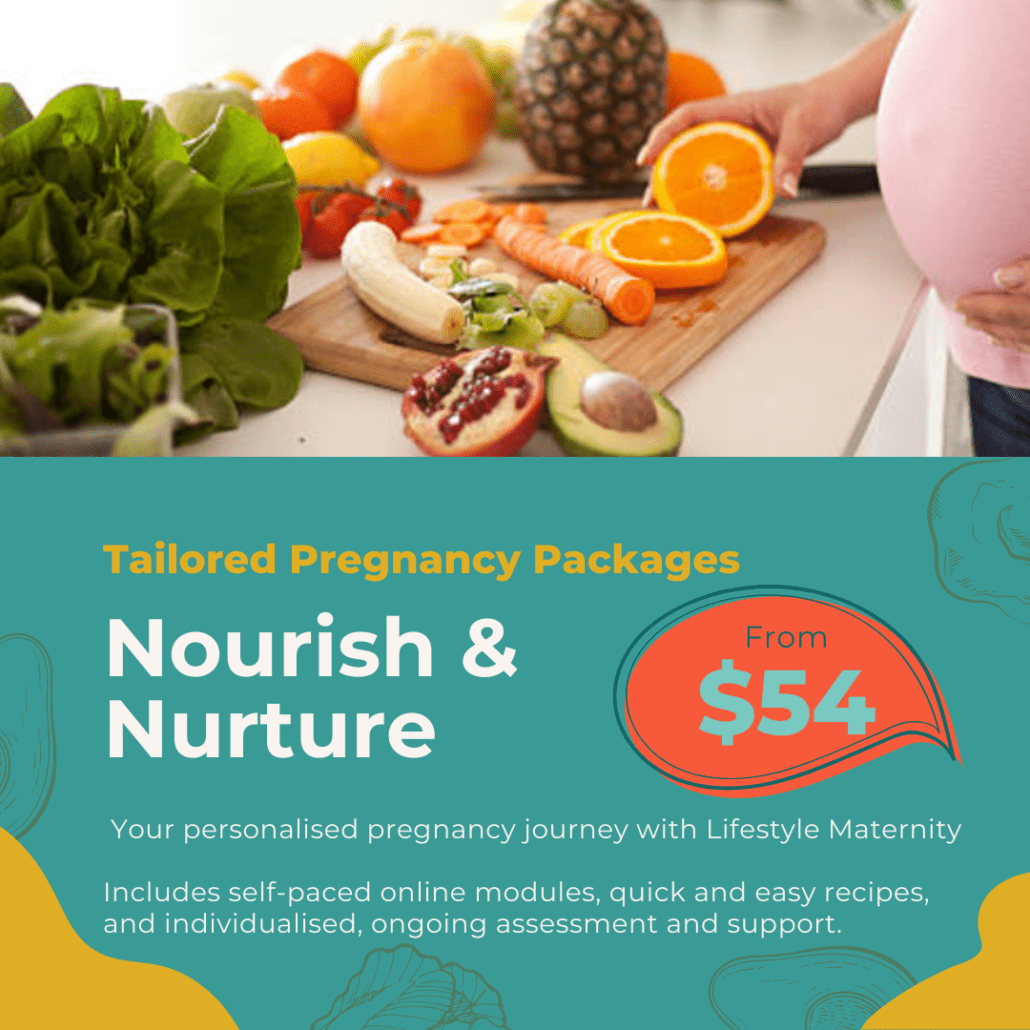Pregnancy nutrition – how do you measure up?
Growing a healthy baby relies on getting the extra nutrients that your baby needs for growth and development. The food and drink you eat is the main source of nutrients for your growing baby. In pregnancy, there are amounts and types of food that are recommended to eat each day to get all the nutrients you and bub need. However, in many surveys across pregnancy, the large majority are not meeting these recommendations.
What do women eat during pregnancy?
Only 10%–40% of pregnant women meet current recommendations for fruit and vegetable intake.
Less than 1% achieve recommenced breads and cereal intakes and extremely low numbers meet pregnancy Nutrient Reference Values for folate, iodine, calcium, zinc, and fibre from food alone.
Less than half consume the recommended nutrient supplements (iodine, folic acid) pre-pregnancy with minimal change once pregnancy is confirmed.
In a study of over 800 women Australia-wide, it was found that no woman had dietary patterns that aligned with recommendations from the Australian dietary guidelines. However, over 60% believed that they did.
A poor-quality diet in pregnancy has been linked with a higher risk of unhealthy weight gain, high blood pressure and anaemia. It can also contribute to a lower birth weight and increased risk of chronic disease in babies into their adult lives.
How do you measure up?
The Australian dietary guidelines recommend expectant mothers eat two serves of fruit and five serves of vegetables every day. Are you getting your ‘2 & 5’ each day? A good way to check how you’re going is by writing out a fruit and vegetable tracker like the one below.
| Meal | Fruit | Vegetables |
| Breakfast | Type:
Serves: |
Type:
Serves: |
| Morning snack | Type:
Serves: |
Type:
Serves: |
| Lunch | Type:
Serves: |
Type:
Serves: |
| Afternoon snack | Type:
Serves: |
Type:
Serves: |
| Dinner | Type:
Serves: |
Type:
Serves: |
| Supper or dessert | Type:
Serves: |
Type:
Serves: |
| Total serves |
|
How might you use the tracker to add more fruit and vegetables to your day?
Work through the tracker thinking of a usual day, or what you ate yesterday, to see how you measure up.
For example, you might have a banana on your cereal (one serve of fruit), some blueberries for dessert (another serve of fruit) and a cheese and salad sandwich for lunch (one to two serves of vegetables depending on how much salad you add). This totals two serves of fruit and one to two serves of vegetables that day.
The tracker will help you see where there are opportunities to add more fruit and vegetables during the day. For example, including them at meals where you haven’t filled in a box or by dishing out larger serves at your meals.
No matter how close (or far!) you are from the recommendations, pregnancy is the perfect time to optimise your eating habits for the health of you and your growing bub.
Need more help?
We offer individual consultations and self-paced online courses as we know you all have different learning styles and budgets. Attending an individual session OR online course with a Lifestyle Maternity dietitian will allow you to assess your diet against recommended guidelines and identify changes that can be tailored to your lifestyle and dietary preferences.
In our self-paced online course you will be encouraged and guided to assess your own health habits against pregnancy recommendations, participate in activities around setting health goals for optimal nutrition and learn how to adapt your routines with confidence to achieve these goals to make them stick. More information here.
An individual consult involves a more thorough assessment of your dietary and lifestyle patterns with a personalised action plan being developed in collaboration with the dietitian. If you would like further information book an appointment now.

IMAGE CREDIT: Unsplash Social Cut
IMAGE DESCRIPTION: Photo being taken of a colourful salad in a bowl with image viewed through phone screen. Two hands holding phone and watch on left wrist turned up to face the camera.
REFERENCES:
Blumfield M, Hure A, Macdonald-Wicks L, Patterson A, Smith R, Collins C. Disparities exist between national food group recommendations and the dietary intakes of women.BMC Womens Health 2011;11:37.
Blumfield M, Hure A, Macdonald-Wicks L, Smith R, Simpson S, Raubenheimer D, et al. The association between the macronutrient content of maternal diet and the adequacy of micronutrients during pregnancy in the women and their children’s health (watch) study.Nutrients. 2012;4:1958–76.
McKenna E, Hure A, Perkins A, Gresham E. Dietary Supplement Use during Preconception: The Australian Longitudinal Study on Women’s Health.Nutrients. 2017;9:1119.
Mishra G, Schoenaker D, Mihrshahi S, Dobson A. How do women’s diets compare with the new Australian dietary guidelines?Public Health Nutrition. 2015;18(2):218-25.
Slater K, Rollo M, Szewczyk Z, Ashton L, Schumacher T, Collins C. Do the Dietary Intakes of Pregnant Women Attending Public Hospital Antenatal Clinics Align with Australian Guide to Healthy Eating Recommendations? Nutrients. 2020;12(8):2438.
Wilkinson SA, Schoenaker DAJM, de Jersey S, Collins CE; Gallo L et al. Exploring the diets of mothers and their partners during pregnancy: Findings from the Queensland Family Cohort pilot study. Nutrition & Dietetics. 2022; 79 (5): 602-615.




 Find us on
Find us on
